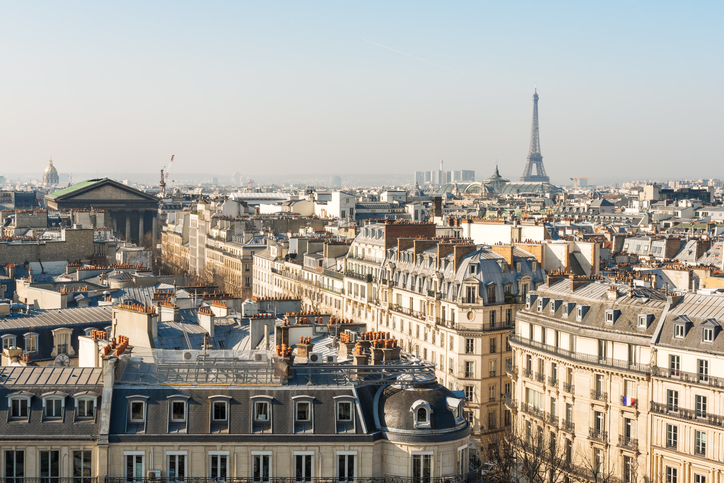The Interior Design Move That Adds Luxury And Always Gets Noticed
Our experts’ advice: Spring for soft colour in a glossy finish on your ceiling.
IF YOU’RE LOOKING to put a room’s décor over the top, lacquer up, say interior design pros. The multi-layered technique yields a mirror-like finish, and when applied to a ceiling, says interior designer Mary Beth Wagner, it brings dynamism and texture to the space. “People notice an interesting detail above because, for the most part, there usually isn’t one,” said the Dallas, Texas, pro. “Most ceilings are white.” Here, Mrs. Wagner and other interiors experts weigh in on what the design move entails, and why you should consider it.
The Appeal: If you want to elevate a space and brim with decorating confidence, says Mrs. Wagner, look to your ceiling, a surface typically taken for granted. In the coming months, the designer plans to coat the ceiling of a client’s dining room in a deep-blue lacquer, with walls of pale blue Venetian plaster. As afternoons wind down in the Lexington, Ky., home of Matthew Carter, the interior designer admires the sinking sun’s reflections on the “fifth wall” of his recently repainted living room, the lacquered ceiling shown right. “It’s a little bit of drama,” he said. Mr. Carter had lived for a year with matte pink overhead, and though he loved the pale hue, “it needed a pick-me-up.” So he colour-matched the existing shade to a Fine Paints of Europe hyper-gloss (similar in colour to Farrow & Ball’s Pink Ground). Its reflective sheen conferred glamour on the entire room. “Everyone comments on it,” he said.
New York City-based interior designer Elizabeth Bolognino lacquered a barely-there peach onto the ceiling of her client’s Manhattan dining room. The impact floored her. “It’s not a bright colour,” she said. “It’s more of this curious little accent, but it plays a big role.”
Both designers wax lyrical about lacquer’s mirroring prowess. During the day, reflections stretch and bend; come evening, flickers of candle- and lamplight sparkle back reflectively. Even wall art gets a boost, said Mr. Carter. “Lacquer enhances the room as a whole and makes you more aware of the backgrounds,” he said, letting art pop.
The Tips: Also known as an automotive or museum finish, true lacquer isn’t an easy fix. But the many-layered process of repeated sanding and polishing pays off. When fully cured, “it looks like glass,” Ms. Bolognino said, watery and gleaming. The technique yields more depth and “wow” than simple high-gloss paint does, said Mr. Carter, noting that some find the effect addictive. If you’re tempted to douse a whole room in the shine, stand down, he says: “It can be too much of a good thing.” Besides, it’s the contrast of painted plaster and a glossy sheen that heightens the effect.
For a larger ceiling, try an uplifting but non-oppressive pale blue, shell pink or ivory lacquer, counsels Mr. Carter. If you want to start small, consider the ceiling of a jewel-box room—a foyer bath or a hidden-away butler’s pantry. In tighter quarters, even an emerald green or saturated yellow won’t overwhelm, he adds.
The Caveats: “There is definitely a price to be paid,” conceded Ms. Bolognino. Applying a lacquer finish is an endeavour best left to a professional. In the Midwest, a 12×15 ceiling will set you back approx. $9300 (or approx. $51 a square foot), reports Mike Foley, of Chicago’s DiVinci Painters. Prices are even steeper on the coasts, he says, averaging around $90 a square foot versus $1.50 for matte. Expect mess and a few weeks of fumes. “Generally speaking, most people tolerate it well when site protection is utilised,” Mr. Foley said, referring to dust- and fume-collecting machines, among other precautions. Fortunately, most people who opt for the specialty finish ultimately feel it’s well worth the cost and tussle, said Mrs. Wagner: “It’s a conversation starter.”
 Copyright 2020, Dow Jones & Company, Inc. All Rights Reserved Worldwide. LEARN MORE
Copyright 2020, Dow Jones & Company, Inc. All Rights Reserved Worldwide. LEARN MORE
This stylish family home combines a classic palette and finishes with a flexible floorplan
Just 55 minutes from Sydney, make this your creative getaway located in the majestic Hawkesbury region.
As Paris makes its final preparations for the Olympic games, its residents are busy with their own—packing their suitcases, confirming their reservations, and getting out of town.
Worried about the hordes of crowds and overall chaos the Olympics could bring, Parisians are fleeing the city in droves and inundating resort cities around the country. Hotels and holiday rentals in some of France’s most popular vacation destinations—from the French Riviera in the south to the beaches of Normandy in the north—say they are expecting massive crowds this year in advance of the Olympics. The games will run from July 26-Aug. 1.
“It’s already a major holiday season for us, and beyond that, we have the Olympics,” says Stéphane Personeni, general manager of the Lily of the Valley hotel in Saint Tropez. “People began booking early this year.”
Personeni’s hotel typically has no issues filling its rooms each summer—by May of each year, the luxury hotel typically finds itself completely booked out for the months of July and August. But this year, the 53-room hotel began filling up for summer reservations in February.
“We told our regular guests that everything—hotels, apartments, villas—are going to be hard to find this summer,” Personeni says. His neighbours around Saint Tropez say they’re similarly booked up.
As of March, the online marketplace Gens de Confiance (“Trusted People”), saw a 50% increase in reservations from Parisians seeking vacation rentals outside the capital during the Olympics.
Already, August is a popular vacation time for the French. With a minimum of five weeks of vacation mandated by law, many decide to take the entire month off, renting out villas in beachside destinations for longer periods.
But beyond the typical August travel, the Olympics are having a real impact, says Bertille Marchal, a spokesperson for Gens de Confiance.
“We’ve seen nearly three times more reservations for the dates of the Olympics than the following two weeks,” Marchal says. “The increase is definitely linked to the Olympic Games.”

Getty Images
According to the site, the most sought-out vacation destinations are Morbihan and Loire-Atlantique, a seaside region in the northwest; le Var, a coastal area within the southeast of France along the Côte d’Azur; and the island of Corsica in the Mediterranean.
Meanwhile, the Olympics haven’t necessarily been a boon to foreign tourism in the country. Many tourists who might have otherwise come to France are avoiding it this year in favour of other European capitals. In Paris, demand for stays at high-end hotels has collapsed, with bookings down 50% in July compared to last year, according to UMIH Prestige, which represents hotels charging at least €800 ($865) a night for rooms.
Earlier this year, high-end restaurants and concierges said the Olympics might even be an opportunity to score a hard-get-seat at the city’s fine dining.
In the Occitanie region in southwest France, the overall number of reservations this summer hasn’t changed much from last year, says Vincent Gare, president of the regional tourism committee there.
“But looking further at the numbers, we do see an increase in the clientele coming from the Paris region,” Gare told Le Figaro, noting that the increase in reservations has fallen directly on the dates of the Olympic games.
Michel Barré, a retiree living in Paris’s Le Marais neighbourhood, is one of those opting for the beach rather than the opening ceremony. In January, he booked a stay in Normandy for two weeks.
“Even though it’s a major European capital, Paris is still a small city—it’s a massive effort to host all of these events,” Barré says. “The Olympics are going to be a mess.”
More than anything, he just wants some calm after an event-filled summer in Paris, which just before the Olympics experienced the drama of a snap election called by Macron.
“It’s been a hectic summer here,” he says.

AFP via Getty Images
Parisians—Barré included—feel that the city, by over-catering to its tourists, is driving out many residents.
Parts of the Seine—usually one of the most popular summertime hangout spots —have been closed off for weeks as the city installs bleachers and Olympics signage. In certain neighbourhoods, residents will need to scan a QR code with police to access their own apartments. And from the Olympics to Sept. 8, Paris is nearly doubling the price of transit tickets from €2.15 to €4 per ride.
The city’s clear willingness to capitalise on its tourists has motivated some residents to do the same. In March, the number of active Airbnb listings in Paris reached an all-time high as hosts rushed to list their apartments. Listings grew 40% from the same time last year, according to the company.
With their regular clients taking off, Parisian restaurants and merchants are complaining that business is down.
“Are there any Parisians left in Paris?” Alaine Fontaine, president of the restaurant industry association, told the radio station Franceinfo on Sunday. “For the last three weeks, there haven’t been any here.”
Still, for all the talk of those leaving, there are plenty who have decided to stick around.
Jay Swanson, an American expat and YouTuber, can’t imagine leaving during the Olympics—he secured his tickets to see ping pong and volleyball last year. He’s also less concerned about the crowds and road closures than others, having just put together a series of videos explaining how to navigate Paris during the games.
“It’s been 100 years since the Games came to Paris; when else will we get a chance to host the world like this?” Swanson says. “So many Parisians are leaving and tourism is down, so not only will it be quiet but the only people left will be here for a party.”
This stylish family home combines a classic palette and finishes with a flexible floorplan
Just 55 minutes from Sydney, make this your creative getaway located in the majestic Hawkesbury region.






















